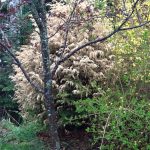
I live on Lake Superior near the Minnesota border. I live on an ancient Stoney beach with sparse topsoil amended in places. This is a first that my cedar and junipers have developed pale yellow spots, completely covering a large globe cedar in one instance although there is some green under the dying ends. I understand that the cause is environmental stress on the root system but I’m wondering how to proceed. I have watered, fertilized the lawn around the shrubs and trees. Do I prune or let nature take its course? Would fertilizer sticks help?
Yellowing or browning of evergreen needles can be part of the natural cycle of evergreens, known as “flagging”. As a general rule, if new growth is healthy, but yellowing needles can be found on the inside of the plant, this is not cause for concern. However, if you notice that new growth is yellowing or browning, you should take a closer look at your evergreens as disease or injury may be the cause. If you know that the cause of the discolouration is that the root system is under environmental stress, rather than any discernible insect pest or disease (bacterial or fungal) then you should concentrate on amending your soil so that your plants receive the nutrients they need. This can be done by applying organic material to a depth of about 4 inches around the trees, making sure that the mulch does not come into contact or mound up around the trunk. Good irrigation is also important. Occasionally over-fertilization can cause discolouration or dieback, so exercise caution if you decide to fertilize.
Yellowing needles can be a symptom of iron chlorosis, a nutrient deficiency common in plants growing in alkaline soils whose pH is higher than 6.5 At this pH level, iron and possibly other micronutrients are unavailable to plants. Chlorosis can worsen over time, and can sometimes result in severe dieback. You can determine your soil’s pH level yourself: most of the large home and garden centres sell soil pH testing kits. Iron chlorosis can be remedied by the application of chelated iron to the soil.
For a general checklist of potential reasons for evergreen browning, please take a look at this website: https://www1.agric.gov.ab.ca/$department/deptdocs.nsf/all/agdex4144
Browning of cedars seems to be very common, and is often weather-related. In Toronto, our warm February weather was followed by a severe drop in temperature and freezing rain in April, with many reports of dieback and desiccation. Your weather on Lake Superior may have been similar: this is a typical scenario in which cedars experience environmental stress. You are doing all the right things for your cedar, but unfortunately, cedars will not regenerate green needles on brown stems, and fertilizer sticks will not help them at this point. Our advice would be to replace this tree. The link Browning Pyramidal Cedars contains a list of archived questions on our website with information on the proper care, fertilization and pruning of cedars for your reference.

